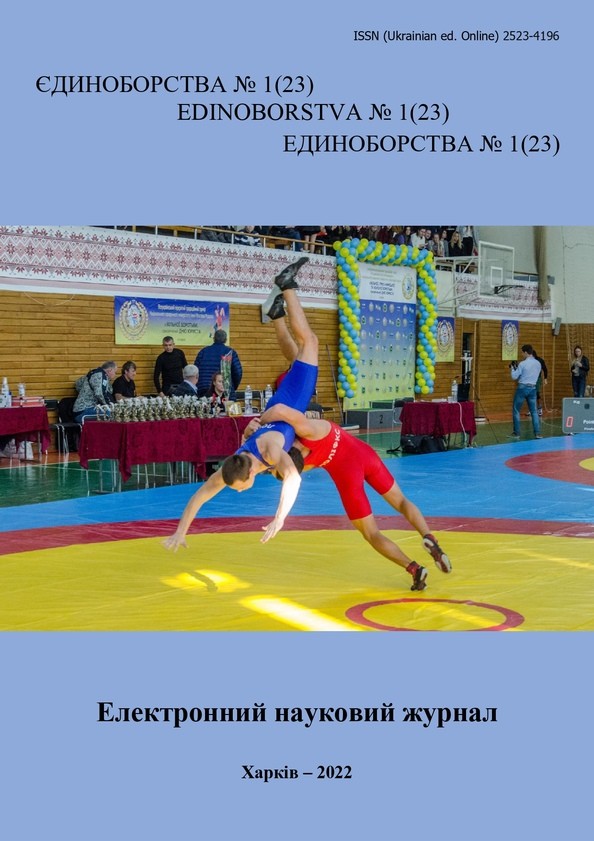Features of sexual dimorphism of neurodynamic functions in women's wrestling
DOI:
https://doi.org/10.15391/ed.2022-1.02Keywords:
female wrestling, sexual dimorphism, neurodynamic functionsAbstract
Purpose: to study the features of sexual dimorphism of neurodynamic functions in women's wrestling. Material and methods. The study involved 24 highly qualified athletes specializing in women's wrestling and 33 highly qualified athletes specializing in wrestling. All athletes are members of the national team of Ukraine. Neurodynamic functions were studied using the hardware-software complex «Multispichometer-05». Functional mobility and endurance of nervous processes and speed of visual perception were studied. Functional mobility of nervous processes was assessed by the ability of the athlete to respond to differentiated stimuli of varying complexity. According to the results of the study, the following indicators were determined: stability, dynamism and bandwidth of the visual analyzer. Endurance of nervous processes was assessed by a two-minute tapping test. According to the results of the study, indicators were determined: endurance and frequency of touches. The speed of visual perception was determined by the perceptual speed test. Non-verbal stimuli (particles of figures) were presented, which had to be differentiated to form a holistic figure. The results of the study determined the indicators: speed, performance, accuracy and efficiency. Results: the study showed that the indicator of stability shows greater reliability in men compared to women. A decrease in the stability index indicates a decrease in the scatter of the reaction time in the athlete. The rate of dynamism of the nervous system in women is significantly higher than in men. The presence of higher values of dynamism in women indicates a better ability to form conditioned reflexes and motor skills. The bandwidth of the visual analyzer is significantly higher in men. This indicates the ability of men to visual perception. Men have a significantly higher rate of endurance. The frequency of touches is also significantly higher in men, which is consistent with the endurance of the nervous system. The rate of processing of visual information is significantly higher in women. While the rate of efficiency of information processing is significantly higher in men. Conclusions. The results of studies have shown that the endurance of the nervous system in men is higher than in women. At the same time, it was found that the speed of visual perception is better in women, and efficiency – in men. This fact also indicates the presence of faster perception of nonverbal stimuli in women, which indicates the predominance of nonverbal intelligence.
References
Вілянський, В.М., & Бачинська, Н.В. (2019). Особливості психофізіологічних показників висококваліфікованих спортсменів з урахуванням статевого диморфізму (на прикладі карате та спортивної акробатики). Єдиноборства. 1, 35-43.
Коробейнікова, Л.Г., Тропін, Ю.М., Коробейніков, Г.В., & Го, Шенпен (2021). Зв'язок когнітивних функцій із спеціальною працездатністю кваліфікованих боксерів. Єдиноборства, 4(22), 26-38.
Лысенко, Е.Н., & Шинкарук, О.А. (2015). Влияние на проявление нейродинамических свойств спортсменов полового диморфизма и напряженной физической работы. Наука и спорт: современные тенденции, 6(1), 11-8.
Тропін, Ю.М., Латишев, М.В., Пилипець, О.В., & Пономарьов, В.О. (2021) Показники змагальної діяльності найсильніших бійців-жінок змішаних єдиноборств ММА. Єдиноборства, 3(21), 69-83.
Шевченко, О.О., Тропін, Ю.М., & Романенко, В.В. (2021). Порівняльний аналіз показників сенсомоторних реакцій борців та спортсменів спортивних ігор з ракетками. Спортивні ігри, 3(21), 80-90.
Aitchison, C.C. (2007). Gender, sport and identity. Sport and gender identities: Masculinities, femininities and sexualities, 1-4.
Baker, R.H, & Wilkinson, G.S. (2001). Phylogenetic analysis of sexual dimorphism and eye span allometry in stalk eyed flies (Diopsidae). Evolution, 55(7), 1373-85.
Korobeynikov, G., Korobeinikova, L., & Chernozubz, A. (2012). Psychophysiological peculiarities of sexual dimorphism in athletes. Psychology Research, 2(6), 336-342.
Pfister, G. (2010). Women in sport–gender relations and future perspectives. Sport in Society, Sport in Society, 13(2), 234-248.
Sterkowicz-Przybycień, K., & Almansba, R. (2011). Sexual dimorphism of anthropometrical measurements in judoists vs untrained subject. Science & Sports, 26(6), 316-323.













